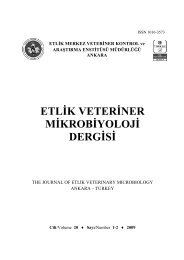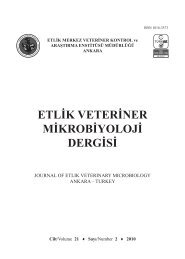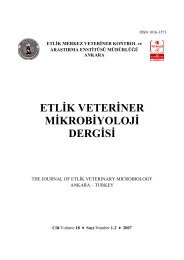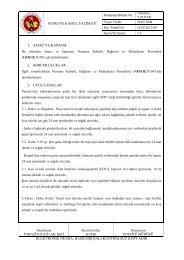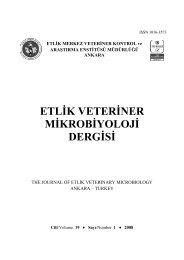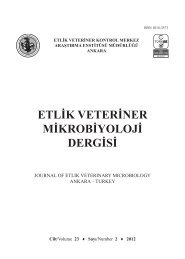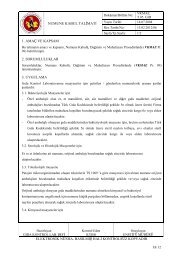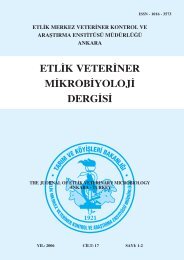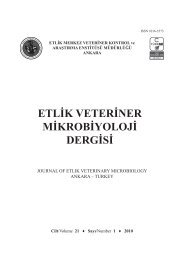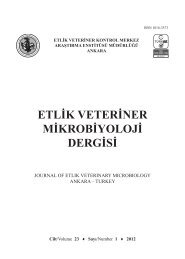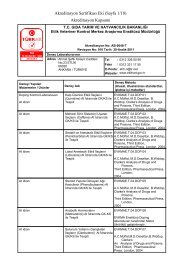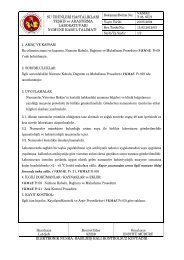etlik veteriner mikrobiyoloji dergisi - veteriner kontrol merkez ...
etlik veteriner mikrobiyoloji dergisi - veteriner kontrol merkez ...
etlik veteriner mikrobiyoloji dergisi - veteriner kontrol merkez ...
You also want an ePaper? Increase the reach of your titles
YUMPU automatically turns print PDFs into web optimized ePapers that Google loves.
Etlik Vet Mikrobiyol Derg, 22, Albayrak 49-53, ve 2011 ark. Etlik Vet Mikrobiyol Derg, 22, 49-53, Araştırma 2011 Makalesi / Research Article 49<br />
Phylogenetic relationships of three bat species from Turkey<br />
İrfan ALBAYRAK 1 , Hikmet ÜN 2 , Nursel AŞAN 1 , Nil ÜNAL 2 , Thomas MÜLLER 3 ,<br />
Conrad FREULING 3 , Orhan AYLAN 2<br />
1 Kırıkkale Üniversitesi, Fen Edebiyat Fakültesi, Biyoloji Bölümü, Yahşihan, Kırıkkale, Türkiye<br />
2 Etlik Veteriner Kontrol Merkez Araştırma Enstitüsü, Etlik, Keçioren, Ankara, Türkiye<br />
3 Institute of Epidemiology, WHO Collaborating Centre for Rabies Surveillance and Research, Friedrich-Loeffler-<br />
Institute, Wusterhausen, Germany<br />
Geliş Tarihi / Received: 07.06.2011, Kabul Tarihi / Accepted: 23.11.2011<br />
Summary: The applicability of DNA sequencing of the Cytochrome b (encoded by mitochondrial DNA) gene was<br />
tested for species delineation and species identification in three bat species (Miniopterus schreibersii, Myotis blythii and<br />
Myotis myotis) sampled from Turkey as a geographic region. Morphologically identified species have also identified<br />
genetically. This study showed that DNA markers are valuable molecular methods for biodiversity monitoring programs<br />
in Turkey. Sequencing-based comparisons could provide more flexibility in large-scale studies for Turkish bat species.<br />
Key words: Bats in Turkey, Cytochrome b, molecular differentiation, phylogenetic analyses, species identification.<br />
Türkiye’de bulunan üç yarasa türü arasındaki filogenetik ilişkiler<br />
Özet: Türkiye’nin farklı iki ilinden örneklenen üç yarasa türünün (Miniopterus schreibersii, Myotis blythii and Myotis<br />
myotis) tarif ve tanımlanmasında mitokondrial Cytochrome b geninin kullanılabilirliği test edildi. Morfolojik olarak<br />
tanımlanmış olan türler genetik olarak da tanımlandı. Bu çalışma, Türkiye’de biyolojik çeşitliliğin izlenmesi programlarında<br />
DNA işaretleyicilerin, değerlendirilebilir moleküler metotlar olduğunu gösterdi. Dizin analizi tabanlı karşılaştırmaların,<br />
Türk yarasa türleri ile yapılacak geniş ölçekli çalışmalarda daha fazla esneklik sağlayabileceği sonucuna<br />
varıldı.<br />
Anahtar kelimeler: Türkiye’de yarasalar, Cytochrome b, moleküler ayrımlaştırma, filogenetik analiz, tür tanımlama.<br />
Introduction<br />
Up to now, 38 bat species have been recorded by<br />
various authors from Turkey (8, 26, 10). Of the 38<br />
Turkish bats, one feeds on fruit while the others<br />
feed insects (10).<br />
These species show variation with respect to<br />
their ecological, biological, karyological and molecular<br />
properties (1-3, 6, 7, 9, 13, 20). Morphological<br />
keys are available to assist the species identification<br />
allowing for the majority of species to be<br />
identified from external and cranial characters (1,<br />
2, 15). However, molecular studies are also reliable<br />
and rapid tools for identifying even morphologically<br />
very similar species (23). Recently, molecular<br />
studies have enabled the determination of some<br />
specimens that were previously unconfirmed, as a<br />
new species (11, 14, 20-25).<br />
Mitochondrial DNA (mtDNA) has long been<br />
treated as an ideal marker because of its convenience<br />
for reconstruction of gene genealogy and<br />
population history inference (16).<br />
In this study, we tested the applicability of DNA<br />
sequencing of the Cytochrome b (encoded by mitochondrial<br />
DNA) gene for species delineation and<br />
species identification in three bat species sampled<br />
from Turkey. Cytochrome b gene is commonly used<br />
for species identification studies and phylogenetic<br />
analysis as a DNA marker (18, 19). This study is<br />
only a preliminary study for our future expectations<br />
and the sequence divergence estimation for Turkish<br />
bat species. We have just chosen three different species<br />
and analyzed cytochrome b gene of this species<br />
to show this study is feasible or not.<br />
Yazışma adresi / Correspondance: Hikmet Ün, Veteriner Kontrol Merkez Araştırma Enstitüsü, Kuduz Teşhis Laboratuvarı, 06020,<br />
Etlik, Ankara, Türkiye Eposta: hikmetu@kkgm.gov.tr



